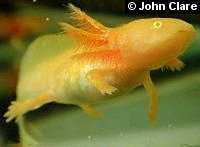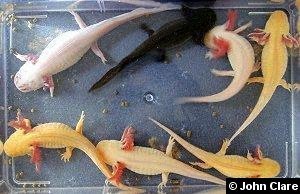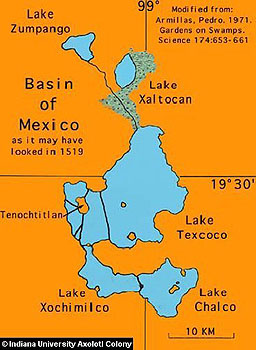| Home | Housing | Feeding | Requirements | Breeding | Biology | Books & Links |

IntroductionWelcome! This web site is devoted to the Axolotl (pronounced Ax-oh-lot-ul), scientific name Ambystoma mexicanum. The site describes the Axolotl's background, biology, and care in captivity. You will also find information about the Tiger Salamander, Ambystoma tigrinum and Ambystoma mavortium spp., because these animals are closely related. 
Australians and New Zealanders frequently refer to the Axolotl as the Mexican Walking Fish, though the Axolotl is not a fish but an amphibian, a salamander, part of the order Caudata/Urodela. Because it's a salamander, it's part of one of the three branches of class Amphibia, which also includes the frogs and toads (the Anurans), and the mainly eel-like order, Gymnophiona, which are also known as the Caecilians. Have a look at the Biology Page for a short guide to the Axolotl's body and characteristics. One common misconception is that axolotls and other salamanders are lizards or reptiles. In fact, amphibians are a completely separate group of animals. For example, did you know that reptiles and human beings have a four-chambered heart? Well amphibians have only three chambers. That's just one example of how appearance can be deceiving: salamanders might look like lizards, but they are very different indeed. This page is a brief introduction for those new to the Axolotl and salamanders. If you require specific information, you can search this site using the search facility at the top right of this page. Caudata.org also contains a wealth of axolotl information and it's a great place to buy axolotls or trade with other hobbyists. Caudata.org is the Internet's premier source of salamander and newt information and it places an emphasis on their maintenance in captivity. There is a very busy axolotl forum at Caudata.org, used by people just like you. I hope that you find this site useful, but most of all I hope you enjoy what you read and find here. If you're looking for information about metamorphosed axolotls, click here.  Axolotls of various colours occur in captivity, including grey, shades of brown, leucistic (white with black eyes), golden albino, white albino, as well as other varieties, such as the melanoid (a near-black animal). The normally coloured axolotl, the "wild type", can be near-black like the one in the group photo to the left, chocolate brown like the one in the site's logo, or even creamy in colour, and anywhere in between. There are even "piebald" axolotls in various colours, and a variety that is piebald in more than one colour, known as the "harlequin". You can learn more about how colour comes about and how it is passed on by taking a look at the Genetics Page. And why not take a look at the hundreds of photos of the weird and wonderful varieties of axolotls submitted by enthusiasts like yourself at the Axolotl Section of the Caudata.org User Photo Galleries? The name "Axolotl" comes from the Aztec language, "Nahuatl". One of the most popular translations of the name connects the Axolotl to the god of deformations and death, Xolotl, while the most commonly accepted translation is "water-dog" (from "atl" for water, and "xolotl", which can also mean dog). 
Prior to the growth of Mexico city in the basin of Mexico, the Axolotl was native to both Lake Xochimilco, and Lake Chalco. Of these two high altitude freshwater lakes, only the remnants of Xochimilco as canals can be seen today. Unfortunately many information sources mention these lakes as if they still exist (such as this ill-researched article about a metamorphosed axolotl on the BBC News Web site). If only this were still the case: sadly it is rarely caught in the wild but at least the Axolotl is now on the CITES endangered species list. There have been efforts to breed and release the animal, in order to re-establish its numbers. However the location of the remaining waterways where the animal may live (located in the Mexico City metropolitan area) are likely to be very threatened by the city's continuing expansion and the days of the species surviving in the wild are surely quite limited. Fortunately, due to the importance of the Axolotl in scientific research, it is unheard of for them to be taken from the wild for that purpose because of the huge numbers bred in captivity each year. There are related Mexican Ambystoma species that also remain gilled as adults. These species are located in water bodies further from Mexico city and may have a slightly brighter future in the wild than the Axolotl. Despite its endangered status, the use of the Axolotl as a laboratory animal should ensure the species' survival, if only in captivity. It has long been known that the Axolotl is a worthy study due to its amazing healing and regeneration abilities. Normal wound healing in animals occurs through the growth of scar tissue, which is not the same as the original tissue, nor is it as robust. Normal wound healing also does not allow for most animals to re-grow a lost limb. However the axolotl is fully capable of complete limb re-growth. The animal has the added scientific attraction of having especially large embryos, making it easier to deal with under laboratory conditions. Its embryo is also very robust, and can be spliced and combined with different parts of other axolotl embryos with a high degree of success. 
The Axolotl is a fascinating creature for a number of reasons, including its grotesque appearance, its ability to regenerate, and primarily the fact that it exhibits the phenomenon known as neoteny. Ordinarily, amphibians undergo metamorphosis from egg to larva (the tadpole of a frog is a larva), and finally to adult form. The Axolotl, along with a number of other amphibians, remains in its larval form throughout its life. This means that it retains its gills and fins, and it doesn't develop the protruding eyes, eyelids and characteristics of other adult salamanders. It grows much larger than a normal larval salamander, and it reaches sexual maturity in this larval stage. Another term to describe this state is "perennibranchiate". The animal is completely aquatic, and although it does possess rudimentary lungs, it breathes primarily through its gills and to a lesser extent, its skin.  It is generally accepted that neoteny is a "backward" step in evolution, because the Axolotl is descended from what were once terrestrial salamanders, like the closely related species, the Tiger Salamander, Ambystoma tigrinum and Ambystoma mavortium spp. (in fact, one likely theory suggests that the Axolotl is in fact a Tiger salamander off-shoot, as it can interbreed with that species with some success). Through some quirk of nature, a neotenous form developed and, probably due to environmental conditions, prospered. Neoteny is sometimes found in other amphibians, but tends to be caused by low levels of iodine (an essential element for animals to make thyroxine hormones, necessary for growth and development), or possibly by random genetic mutation. Research has also shown that very low temperatures can suppress the production of these hormones, thus also inducing neoteny. In the Axolotl, neoteny is now totally genetic (click for more information on the Axolotl's genetics). When treated with hormones, the axolotl will usually begin to metamorphose, but in very rare cases it will metamorphose spontaneously, such as the metamorphosed wild type axolotl pictured here. The metamorphosed wild type axolotl bears a close resemblance to the Mexican race of the Tiger Salamander, Ambystoma velasci. There is a wonderful thread on the Caudata.org forum here about the metamorphosed axolotl in the photo. Unless cited in the Acknowledgements, all text and images are ©1998-2019 John P. Clare. All Rights Reserved. Bookmark Axolotl.org with:
What are these? This site was first published in 1998. There have only been minor edits since the early 2000s.
| ||||||||







 reddit
reddit Facebook
Facebook